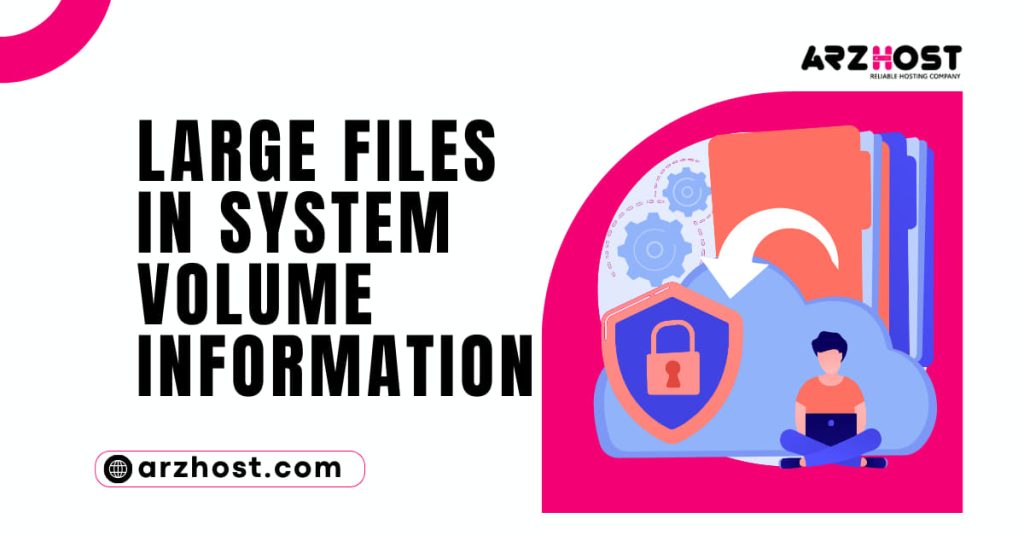There is a coordinator named present on each drive on your PC. Whether or not it is your hard drive or some external USB contraption you plug in your PC. Large Files in System Volume Information. This coordinator is concealed and you might potentially see it on the off chance. You have engaged the decision Show stowed away records and envelopes in report pioneer.
Around here at ARZHOST, the drives which are coordinated with the NTFS record system cannot get to the envelope. To be sure, “Large Files in System Volume Information”. Even heads are avoided getting to the envelope. You will get an error Access is denied or Region not open.
This lead is common as Windows uses this envelope for structure-level arrangements. The approvals are set as a safeguarding strategy to hold unfortunate customers. Applications back from modifying the substance inside. Intruding with the structure action.
What is System Volume Deta used for?
System Volume Information is used for an assortment of purposes, for instance. Taking care of structure restore centers. Information regarding Hosting Expert informational collection “Large Files in System Volume Information”. Data related to Volume Shadow Copy organization for fortifications. The Distributed Tracking Services are used to fix joins and different backup courses of action.
You can probably get to this coordinator. When you are using adaptable drives (USB) as the record type isn’t NTFS (it may be FAT32 or exFAT). There are for the most part two coordinators present WPSettings.dat and IndexerVolumeGrid.
Indexer Volume Grid
The Indexer Volume Grid gives out a stand-out identifier to the drive. The Indexing Service then separates the reports. Your drive and record them so they can be gotten to even more quickly. “Large Files in System Volume Data”. Whenever you interface the drive to the PC. Windows will look for the identifier and sort out which search informational collection to direct and associate the drive with. This way you can use distinctive chase decisions on the drive (Cortana, File traveler, etc).
To stop things System Volume data isn’t some other envelope. Windows don’t need and are essentially there. Plays out a critical occupation in getting to your drives whether they are conservative or fixed.
How should I diminish the size of the coordinator?
The bigger piece of the customers who run over this coordinator whimper that it takes a huge load of circle space on their hard drives. “Large Files in System Volume Data”. Basically, consider the way that organization Volume Information contains your structure restore centers. Structure restore centers are photos of your system gotten either truly or therefore. You can use this to restore your system to a past point if something goes bad later on.
You wanted to cripple the structure restore and remove any restore centers (if present). “Large Files in System Volume Information”. Do observe that this will eliminate the restored helpfulness of your structure. Maybe then thoroughly crippling the component.
Restore centers and check whether that takes care of business
- Press Windows + R, type “control board” in the trade box, and press Enter.
- Select the sub-class “System and Security” from the overview of decisions.
- As of now click on “System”.
- As of now click on System Protection present at the left 50% of the screen. You might require legitimate benefits to see this decision.
- Here you will see all of the drives which have a restore point open and are hailed under got drives. Snap-on “Mastermind”.
- You will see the current of the restore point. Do observe that the most outrageous use normally is set to 10 GB of room.
- This infers that structure restore can eat up as much as 10 GB without any difficulties. You can change the best space it can consume by moving the slider or contributing the number similarly.
Investigate the current. If you feel that your PC is working precisely and there may be no need for restore centers made previously. Click on “Delete” to annihilate the past restore centers. Large Files in System Volume Data. You can in like manner check. Disabled person structure protection to incapacitate the framework completely.
Would I have the option to remove System Volume Data?
The fitting reaction is yes and no. You can’t remove System Volume Information present on your hard drives. You can’t get to it. “Large Files in organization Volume Information”. Leave alone eradicating it. You can regardless remove the coordinator on your removable drive yet Windows will make it again normally.
 This envelope is significant for the action of Windows and contains a couple of functionalities. “Large Files in organization Volume data”. No issue has been represented with this coordinator besides consuming a great deal of plate space.
This envelope is significant for the action of Windows and contains a couple of functionalities. “Large Files in organization Volume data”. No issue has been represented with this coordinator besides consuming a great deal of plate space.
Directions to Access Volume Data Folder on Windows
The System Volume Information envelope is normally made at the establishment of each drive. “Large Files in System Volume data”. Commonly stores data related to System Restore Indexing File History etc
This envelope is disguised as per usual. Therefore, to make this coordinator perceptible. We assist planners with crippling the decision Disguise guaranteed working structure archives in File Explorer. On the other hand “Large Files in System Volume data”. They moreover use the going with PowerShell script:
- $regkey = ‘HKCU:\Software\Microsoft\Windows\CurrentVersion\Explorer\Advanced’
- Property $regkey Hidden 1
- Item Property $regkey HideFileExt 0
- Set-Item Property $regkey ShowSuperHidden 1
- Stop-Process – Process Name pioneer
File Explorer customers get a passageway denied error as shown underneath:
We assist planners with designating the customer as the vault owner and grant the record the NTFS agrees to get to it. Any way we can do it through the Security tab in envelope properties. “Large Files in System Volume Information”. We can in like manner perform it viably from the request brief using the request underneath:
takedown/f "C:\System Volume information"icacls"C:\System Volume Information"/grant arzhost\arz
Then again “Large Files in System Volume Information”. We can similarly see the substance of the System Volume Information. List by running the PowerShell console with NT AUTHORITY\SYSTEM benefits:
exe - I - s powershell.exe
To see the substance of a coordinator run the request:
Child Item 'C:\Organization Volume Information\'
As of now “Large Files in System Volume Information”. We can find the size with the going with PowerShell request:
(Get-Child Item 'C:\System Volume Data\' | measure Length - s). sum/1Gb
Finally, “Large Files in System Volume Information”. We can restore the main approvals on the System Volume Information envelope using:
icacls "C:\System Volume Data"/set owner "NT Authority\System"
Guidelines to fix Disk full due to tremendous System Volume Information Folder on Windows
Structure Volume Information coordinator stores information for system recovery and data for some fundamental organizations. “Large Files in System Volume Information”. It isn’t recommended to truly remove records in this envelope. Any way we can clean up the System Volume Information list by devastating the structure restore centers. Record history isn’t for the most part palatable.
We can show what is taken care of in this library by showing the bits of knowledge of using shadow copies
vssadmin list shadow storage
This will show the nuances of the shadow copy storing. Windows normally appropriate 10% of the total plate size for taking care of shadow copies. “Large Files in System Volume Data”, We can diminish the circle use limit of VSS to 2 GB using the vssadmin request. The vssadmin request has the going with sentence structure:
vssadmin resize shadow storage/on= [drive letter] :/For= [drive letter] :/Maxie= [maximum size]
We can remove all old structure state copies using (in the Windows Server variants when we make system state fortifications using Windows Server Backup):
wbadmin remove systemstatebackup - keepversions:0
“Large Files in organization size Information”. To quickly clean up old types of VSS reviews on Windows Server. Use the disk shadow Tool:
Disk ShadowDelete shadows OLDEST c:\
Each time when the request run. It deletes the most settled shadow copy (see) of the volume.
Clean Up Duduk Chunk Store in System Volume Information
While separating the substance of the System Volume Data coordinator on Windows Server. “Large Files in System Volume facts”. Our Hosting Expert Planners routinely notice that the Duduk\Chunk Store inventory is gobbling up a lot of room. This suggests that the archive deduplication incorporated is enabled for this volume.
The Windows Data Deduplication organization replaces undefined irregularities (parts) in reports on a volume with an association with the extraordinary piece. It then, “Large Files in System Volume Data”. Saves this to the System size number index.
While we move or remove overhauled records from a reduplicated volume. It doesn’t delete the old irregularities immediately. An unprecedented Garbage Collection work that runs once seven days dispenses with these squares. In this manner. It doesn’t speedily recuperate space on a deduplication-enabled volume.
To speedily start the technique associated with wiping out unused bumps run the PowerShell request:
start-dedupjob - Volume C: - Type Garbage Collection
“Large Files in Structure Volume Number”. The accompanying dedupjob occupation will take a gander at the uprightness of the extra bumps:
To screen these tasks use the Get-Dedupjob cmdlet.
“Large Files in System Volume data”. Deletes unused knots in the System Volume data vault and frees additional plate space.
Conclusion
The plate full rebuke in windows can in like manner trigger given the tremendous structure. Volume data Folder. “Large Files in organization Volume Information”. Today we saw how our Hosting Expert Planners Access System. Volume Information Folder and clear up the circle space.
People Also Ask
Learn About System
Question # 1: Why is my System Volume Information folder so big?
Answer: The more often shadow copies are created. The more often the files on the disk change. The faster the size of this directory grows. In the screenshot below. You can see that in the System Volume Information folder there is a system file larger than 160 GB.
Question # 2: Can I delete files from System Volume Information?
Answer: You shouldn’t delete the System Volume Information folder. On NTFS-formatted drives. Windows won’t normally let you access this folder much less delete it. On exFAT or FAT32-formatted drives. You can choose to delete the folder. Windows will just recreate it in the future since it needs it.
Question # 3: How do I remove system volume information from Windows 10?
Answer: Click on Start and go to Settings > organization > About > System info. Select System protection on the list on the left-hand side. In the list under Protection settings. Select the drive for which you intend to delete the System Volume Data folder and then click on Configure.
Question # 4: What are the files in system volume information?
Answer: System Volume Data is a folder that’s found on every computer partition. It’s a hidden system folder that your computer’s System Restore Tool uses to store its information and restore points. This folder is used by Windows for system-level functions. That’s why you can’t access it.
Question # 5: How do I reduce system restore points?
Answer: Under Protection Settings, select your local drive and then click the Configure button. Under the Disk Space Usage section slide. Max Usage slider to the percentage of space you want to use. Keep in mind that when you lower the amount of space older restore points will be deleted.









